Text
UP Isn't For Fluffy
By Kimberly C. Villegas

Photo courtesy of runningpinoy.wordpress.com
On October 4, the Friends for Campus Animals (FOCA) together with almost a hundred companion dogs and their owners gathered at the UP Sunken Garden for the Doggie Picnic for a Cause. The cause? To touch the hearts of the people and the school administration to finally allow pets and animals in the University of the Philippines Diliman.
After all, they say, pets are therapeutic and could provide noteworthy services to the UP community.
The animal lovers say they are doing all these for the sake of achieving a "more humane campus."
Essentially, FOCA want to open the campus for outsiders' pets, for students' pets whom they want to bring with them inside their dorms, and for stray animals to freely roam around the area.
I have nothing against loving animals or owning a pet and having the freedom to go out and play with them. However, there is one common problem in sight between the first two goals: animal wastes.
Well, UP can strike a compromise: they can allow outsiders and students to bring their furry companions inside the campus, but only within a designated place and during designated hours, and provided that they will follow a set of rules for cleaning up their own pet's mess. UP can also hire additional personnels to be on the lookout for people who will violate the rules.
But what are the problems there? First, it will hurt to hire more personnels given the cheapskate attitude of our administration. Second, if we choose to do so, we need not 1 personnel, not 2, not 5, not even 10. We need a lot.
According to the campus' Chief Administrative Office, there are averagely 120,000 people who come and go UP. What if one third of them--that's 40,000--bring their pets to UP all at once? Can the campus afford to employ enough personnels to conduct obedience and behavior test on each of those 40,000 owner-pet pair, when the administration cannot and would not even release funds for school facilities and free education for all?
If a personnel has found animal waste but was not able to catch the culprit on act, it's quite impossible to trace and punish the pet owner. Ending? Additional work for contractual, underpaid UP personnels.
Now the issue of being a pet-friendly campus does not stop there. Three months back, FOCA and the Compassion and Responsibility for Animals (CARA) successfully stopped the implementation of a memorandum issued by the UP Community Relations Office ordering the catching of stray animals within the campus.
“We would like to round them up to neuter them. This is the humane and scientific way of controlling population of strays,” says CARA Philippines President Nancy Cu-Unjieng.
People, if your administration is such a corrupt one like UP's, we have to set our priorities. In times like this when the UP community is facing commercialization schemes, tuition fee increase, and lack of adequate financial support, is it just right to ask for funds from the tightwad administration to desex a stray animal? Makikigulo ka pa ba naman?
Education or stray animals? You choose.
It's not that trap and kill is the better alternative. In fact, it is undeniably an inhumane way to control feral cats and dogs. However, it does not also follow that trap-neuter-release (TNR) is the way to go. Why don't we just look for people out there who are more than willing to adopt these cats or dogs and can give them focused attention and care?
TNR advocates may state that we cannot socialize or give sanctuary to feral cats. Likewise, we cannot TNR hundreds of feral cats. Duh, is it possible to really and accurately keep track of stray animals inside a 1,220-acre university?
Actually, one basic problem here is the very fact that they roam around, and by such they can most likely cause community problems. One wrong timing in crossing the road may cause road accidents, not to mention the fecal wastes these stray animal will be making around.
Come on, for the sake of the motorists and students and pedestrians along UP's busy streets, just let these stray animals be adopted. Hindi ka pa gagastos sa pagt-TNR.
After all, TNR is not really effective.
Numerous animal welfare organizations around the world have realized and proven how ineffective this method is. If not done regularly on a hundred percent of all the stray animals inside UP--which in the very beginning is already impossible--they may not eradicate the detrimental effects of the numerous other diseases they carry such as rabies. Rabies vaccinations do expire, and if their ain't enough funds from the admin to continue regular vaccination, you are putting the cats at risk for spreading this fatal disease.
Also, not all stray animals are trapped, therefore not all stray animals are vaccinated.
Lack of adequate funding, which is a given in UP, will also lead to other stray animals' diseases being left untreated, which again will more likely promote its spreading. These include intestinal parasites, such as roundworms and hookworms as well as external parasites like ticks and fleas.
If you advocate for a pet-friendly campus and your solution to regulate stray animals is TNR, you are simply creating a problem that was not even there in the first place.
It is not UP's responsibility to give home to stray animals that might grow and grow in number overtime, divide their already limited funds to TNR animals regularly, and pose additional responsibilities to students and personnels. If you want a place where you can freely hug and pet stray animals, go somewhere else, not in an already populated place like UP.
UP is a learning institution, not a pet nursery. Time to set priorities, folks.
0 notes
Text
How to possibly juggle orgs with acads?
by Precious Prestosa

Photo courtesy of UPCE
Studying in UP Diliman is no ordinary challenge to each and every Iskolar ng Bayan. You are the cream of the crop, the 3,000 among the 80,000. Everyone expects you to lead, excel, and succeed.
But it is no easy task. For Bea Angala, she has five student organizations, not counting outside affiliations, and in good academic standing as a BA Geography undergraduate student in UP Diliman.
She started joining orgs while she was still a freshie. Being a trained leader (in high school, she’s part of the school student government), it wasn’t as hard as it was to others for her to adjust in the life in the University. She said that her first org, UP Junior Marketing Association (UP JMA) has helped her grow as an individual. She started handling projects in the said organization that taught her life beyond the four walls of our classrooms, but an eye-opener to the real world, to the corporate world.
She then joined UP Circle of Entrepreneurs (UPCE), which according to her, has given her the greatest lesson among her student organizations when it comes to leadership, event-handling and maybe yes, life in general. She is currently the head of the social arm project of UPCE, PAGASA, which aims to help communities in creating livelihood through entrepreneurship, for them to be self-sustaining.
She is also doing a start-up business, Tipsy Co., with her friends in UPCE, plus other affiliations outside the university. But despite all these overwhelming commitments, she is still able to manage her life as a student, maintaining good grades.
Bea is a shiftee from BS Statistics to BA Geography. Adjustment in her course choice had been easier because of her orgmates who helped her by giving her tips such as what subjects to take first, which professors to choose from, etc. Being a member of an academic organization could greatly help the student because resources are also being made available. Upperclassmen can give their former readings to their juniors and even teach them about matters that are unclear to them.
Your orgmates could also be your study buddies, willing to be with you as you pull off an all-nighter. They also serve as your social support when you’re already drowning with your requirements, both acad and org-related.
Joining an org should not be a scary task nor a burden to someone. Joining an org is an avenue for you to improve as an individual and help others to improve as well. You help others the same or even in more ways that your seniors have helped you.
According to Bea, you just need to do three things:
1. Set your priorities right.
2. Love what you’re doing.
3. Be faithful to your commitments.
Watch to what she has to say for those who wish to serve well in their academics and organizations!
youtube
0 notes
Text
Paano Nga Ba Mag-Move On (Ang Shiftees and Transferees)?

Of adjustments and changes: Iskolars and their Words of Wisdom
by Ashery Andrea I. Pisano
They say nothing in the world is permanent except for ‘change.’ One way or the other, we will be facing new chapters of our lives where we might have to leave that which we thought we’d forever have (may forever ba?).
When one goes to college, he/she faces major changes: new lessons, new environment, new faces, new experiences and sometimes, even new decisions to make. The University of the Philippines (UP) community acknowledges the individual’s liberty to change his/her mind and follow where his/her heart must be leading him/her.
Hence UP students are among the many who are given freedom to choose to shift in/out out of their courses and/or transfer to another campus. But starting anew is not always as easy as A-B-C.
For the brave Iskolars who are at the verge of their adjustment periods, don’t worry, you are not alone. Your fellow Iskos and Iskas from UP Diliman got your back with their words of wisdom cause they’ve been there and they’ve done that.
Read, relate and learn as 6 of them speak straight from experience!

1. JANINA BAUTISTA. Batch ’12 Transferee from UP Baguio. Formerly majoring on BA Communication. Currently taking BA Journalism, 4th year.
I transferred to UP Diliman because...
Sabi ng nanay ko. Nung nasa UP Baguio ako, wala naman talaga akong intention na lumipat sa Diliman. UP Baguio din kasi first choice ko sa UPCAT, gusto ko kasi nang malayo. Pero nung kalagitnaan ng second sem ko nung first year, try ko daw lumipat sabi ni Mama. Si Mama lang kasi tumutustos sa pag-aaral ko, mula tuition fee hanggang living expenses sa boarding house at pagkain. E sobrang mahal ng cost of living sa Baguio, medyo high-end na city kasi. Alam kong nahihirapan si Mama sa mga gastos ko nun, kaya pinilit kong makalipat. Nag-apply ako sa CSWCD at CMC, pasado naman pareho kaya eto nandito ako ngayon.
When I left my former campus and stepped on UP Diliman grounds...
Medyo ironic, kasi nung first time kong makapunta ng UP Diliman noong high school para magpasa ng UPCAT at nagkandaligaw-ligaw kami sabi ko sa sarili ko, "Hinding-hindi ako mag-aaral dito sa Diliman, ang laki eh.” Nung inaasikaso ko yung pag-transfer ko sa Diliman, hindi ako naeexcite. Natatakot ako kasi wala naman akong kakilala dito. Kaka-adjust ko lang nun sa Baguio tapos mag-aadjust na naman ulit dito. Mahirap umalis sa Baguio kasi nandun yung friends ko, pero wala akong nagawa kundi iwan sila kasi kailangan eh.
Time it took before I was able to adjust:
Matagal bago ako naka-adjust sa Diliman. Sa unang semester ko dito, hindi ko pa rin kabisado yung mga colleges tsaka routes ng jeeps.
How I was able to cope:
Naka-adjust naman sa college kasi may mga mababait na upperclassmen from a college-based organization na tumutulong/nag-guide sa'kin. Sumali ako ng orgs nung pagkalipat ko. Dahil siguro sa pagsali na yun, mas naging gamay ko yung Diliman tsaka mas nalaman ko kung anong klase ng mga tao yung pwede kong makasalamuha dito.
Para maka-move on, I advise adjusting Iskolar transferees/shiftees that...
Kayo unang mag-approach sa classmates niyo sa GEs or major subjects niyo. Malay niyo, nahihiya lang din sila na i-approach kayo. 'Di niyo alam, sila pala maging friends niyo sa buong college life niyo. 'Di naman necessary na sumali ng org, pero it's a good way to meet (lots of) new people.

2. DARIEN MITCHELL BAS. Batch ’13. Transferee from Far Eastern University- Manila. Formerly majoring on BA Communication. Currently taking BA Broadcast Communication. 3rd Yr. Standing
I transferred to UP Diliman because...
I honestly felt I deserved a better education for myself because FEU was not giving me the kind of education that I wanted.
When I left my former campus and stepped on UP Diliman grounds...
I actually stepped on UPD's campus grounds many times in high school so, the place was familiar to me but the first time I stepped in UPD as a transferee, I felt elated, as if I've achieved something monumental and I didn't think much about my previous university.
Time it took before I was able to adjust:
It took me a while to adjust to UPD.
How I was able to cope:
I was admittedly a bit boorish which is why I had trouble making permanent friends. I eventually learned the ropes and found great friends in my college and outside of it.
Para maka-move on, I want to tell adjusting Iskolar transferees and shiftees that...
UP life is kind of hard when you're dealing with it alone so, I joined the UP Singing ambassadors for a while, then UP Journalism Club where I found the best group of people who I genuinely consider my friends.

3. ERIZA VALERIANO. Batch ’10. Transferee from UP Baguio. Formerly majoring on B Fine Arts.Currently taking BS Architecture. 5th Year.
I transferred to UP Diliman because...
[I had] two reasons: (1) Distance - not a problem to me but to my parents. They wanted me to study somewhere near (Baguio is 7 hours away, Antipolo is 1/2-2 hours away so it’s relatively near). (2) It was the original plan; my first course choice in UP which I failed to meet the quota of. So even before I actually started studying in UP Baguio I had plans of transferring and shifting.
When I left my former campus and transferred to UP Diliman...
I was sad. I didn't expect to love UP Baguio and everything in it as much as I did in my 10-month stay. Besides, Baguio is one of my favorite places in the country so I really enjoyedstudying and staying there. [When I first stepped on UP Diliman grounds, though, I was] nervous and excited. More nervous than excited probably. It was my first time to transfer schools, per stage at least. From nursery to sixth grade I stayed in one school. The entire high school I stayed in one school. I wasn't used to meeting different sets of classmates.
Time it took me before I was able to adjust:
Entire first year was adjustment period. By second year I have established close ties with people in my batch and the circle grew and grew through time.
How I was able to cope:
It helped to be friends with as much people in the college. Made Arki a little less stressful. Also, there were days I just observed the campus to appreciate its beauty and vastness. There’s no denying UPD opens a lot of doors, we just have to actually be there and strive to enter. Profs and friends alike [helped me]. There were profs I encountered in my 5 years in UPD who made me realize how privileged I am to be studying in the campus; I wouldn't have met them if I didn't transfer (although there are A LOT to miss in UPB). Friends (and family) [also helped me], as mentioned before, make Arki worth stressing for.
Para maka-move on, I advise adjusting Iskolar transferees/shiftees to...
Focus on the goal. Besides, there must be a good reason why you transferred/shifted. There will always be times we can't help but look back—it's a good thing for one because it means we enjoyed our time in our previous campus/college—but just my two cents: the lives of the people we left behind didn't stop the moment we left. Life goes on kaya move on na!

4. MARKO NIKO BALOLOY. Batch ’12. Transferee from UP Los Baños, formerly majoring on BS Agricultural Biotechnology. Currently taking BS Geography. 3rd Year Standing.
I transferred to UP Diliman because...
[I would have] less expenses and makakapag-uwian ako everyday.
When I stepped on UP Diliman grounds...
I thought walang bago, same culture as what I got to experience sa UPLB pero hindi kasi mahirap pala mag-gain ng friends dito pag di ka friendly unlike sa LB. Tapos yung competition within the classroom ay grabe unlike sa LB, friendly-competition. After experiencing 1 year sa Diliman, na-realize ko na mas gusto ko ang setup sa UPLB, with the people.
Time it took me before I was able to adjust:
One semester to one year.
How I was able to cope:
I joined orgs para may mga makilala ako ng lubos as I stay sa UPD for [the] undergraduate program.
Para maka-move on, what I want to tell adjusting Iskolar shiftees/transferees is...
Gusto ko sana itanong kung pinag-isipan ba nila ang pag-transfer sa program nila ngayon and gusto ba talaga nila.. [But] I would say, minsan siguro darating na manghihinayang ka pero try to seek from within yourself what you can do in the program you are taking now. Wag isipin na ayaw mo siya, subukan mong i-enjoy dahil dun ko na-realize na natutunan din palang ma-appreciate ang ibang programs once you get the chance na -ma-orient ng maayos about it. But once alam mo na ang ginagawa ng program mo but still find yourself unfulfilled, I would suggest to think again and re-assess what you want to do it life. Also, yung undegrad naman hindi lang diyan matatapos life mo, pwede ka mag-specialize sa post-grad mo sa mga bagay na mas o gusto mo talaga.

5. ANTONETTE CARIÑO. Batch ’12. Transferee from UP Baguio. Formerly majoring on BA CommunicationCurrently taking BA Journalism. 4th Year.
I transferred to UP Diliman because of...
Peer pressure. I want to try a new environment. Main reason: gusto long mag-engineering as Diliman.
When I first stepped on UP Diliman grounds, I thought...
[UP Diliman was] so big. People are really intellectuals. [I was] sad because there are memories left and can't be done in UPD.
Time it took me before I was able to adjust:
One semester.
How I was able to cope:
I hangout with my friends from high school who also transferred to Diliman. I met new friends, focused on acads, and joined organizations.
Para maka-move on, I advise adjusting Iskolar shiftees/transferees to...
Just balance acads and fun. Create new memories, and you'll see the right time will come for you to move on but of course don't forget the memories you got from your past school because maybe in some time you can use it in your new environment.
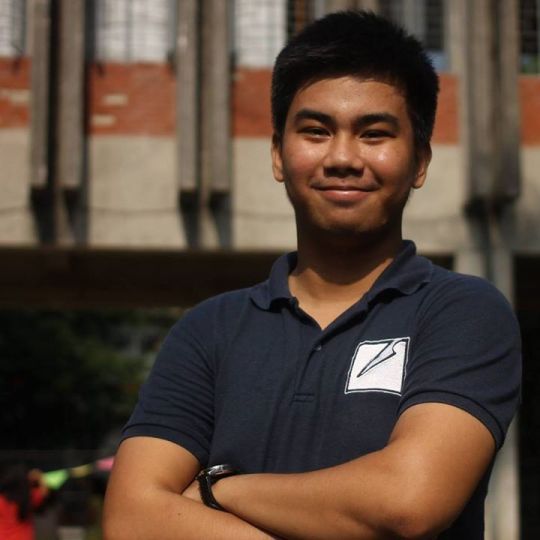
6. ERWIN COLCOL. Batch ‘12. Transferee from UP Manila. Formerly majoring on BA Orgnizational Communication. Currently taking BA Journalism. 4th Year.
I transferred to UP Diliman because...
Journalism was my first choice course when I took the UPCAT. When I got accepted in UP Manila, I promised myself that I would shift to UP Diliman after a year. I was lucky that I got good grades back in my freshie year, I was able to meet the required GWA to transfer.
When I first stepped on UP Diliman grounds...
Of course, I was culture-shocked. UP Diliman is a very big campus and I always got lost in my first few weeks here. I remember that I only stepped twice on UP Diliman before transferring, so I was very unfamiliar to the place. ‘It was hard for me to leave UP Manila because I have friends that there whom I would not be seeing more often.”
Time it took me before I was able to adjust:
It took me one semester, I think?
How I was able to cope:
I applied in an organization to meet new friends, and I’ve never felt lonely since.
Para maka-move on, the advice I give to adjusting Iskolar shiftees/transferees:
Join organizations. There are orgs out there that are very friendly to shiftees and transferees. They will not only help you adjust to your new environment, but will also become your classmates and friends who will help you along the way.

Social support, time and focus -- whatever style that worked for the five Iskos and Iskas who chose to adapt to change may or may not work for you. Whether you’re still having a difficult time adjusting, just remember many have gone through that, and sooner or later, you yourself will learn your own coping strategies. Hintay lang, makaka-move on ka rin!
0 notes
Text
50-peso-meals around the campus
By Renz M. Almenanza

After a fire gutted the CASAA Food Center, students of the University of the Philippines Diliman have been in search of places to eat. Maginhawa Street is known to be a food haven but the price range of the food there is not that friendly to many iskolar ng bayan especially to dormers.
Meanwhile, food trucks are allowed to operate at the AS Parking Lot to cater the students’ demand for food. Still, prices of the food here are around P100.
Fortunately, there are a lot of eateries inside the campus that serve 50-peso-and-below-meals. Three Oble points are given to the eateries with friendly price, prim place, and food options.
Here they are:
1. Maskom’s siomai rice

College of Mass Communication (CMC) students who can’t afford to have lunch at the café inside the Plaridel Hall flock to the Media Center to buy siomai rice. Managed by the CMC Cooperatives, this stall has been up for almost two years serving not just siomai but also barbeque, vegetables, beef tapa, and other viands that vary every day.
One can choose between pork or beef siomai for P25 or P30 respectively, with additional P10 for rice. A rice meal with two sticks of pork barbeque is for P45 only. They are open from 7AM to 7PM but the rice meals are already sold-out by 5PM.
For a small stall, three to four options of meals is commendable and the prices are really cheap. Benches are propped along the hallway of the media center but tables are limited and diners usually take out their meals.
Rating:

(Half-oble-point short due to limited space to dine in.)
2. Lutong bahay
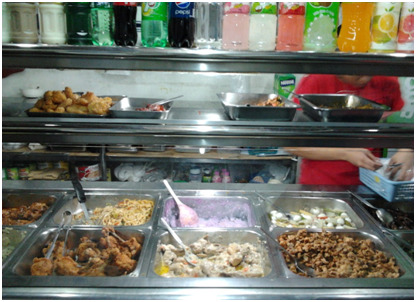
The next eatery has been serving the iskos with lutong bahay since 2002. Lola Lita’s starts its store hours in the Shopping Center at 7am and closes at 8pm. With its wide option of viands, customers usually experience hard time in choosing what to eat (no kidding).
Chicken meals are at P50 while vegetables range from P30 to P40. Some if not most of the meal are already a bit higher than P50 which is still affordable but already exceeds the typical dormer’s budget for one meal.
Meanwhile, Lola Lita’s had turned their second floor as their dining room. Ample tables and chairs are provided that the volume of diners still fits even on lunch breaks.
Rating:

3. Witty

Kainan ng mga Pilosopo sa Peyups or simply KP², is the newest stall along the streets of the Area 2. Serving all-time favorite silogs, KP² has been in the business for almost two months. The names of their meals are derived from, obviously, philosophers: “Longganisa ni Engels,” “Foucault’s Fried Chicken,” and “Confucious’ Adobo Tsino” to name a few. Even Jose Rizal’s fictional character is included in their menu: “Tocino ni Tasyo.”
Only three meals are pegged at P49 and the rest are available for P59. Monoblock chairs are positioned beside their kiosk for customers who want to dine in. And here’s a deal, they are offering a free delivery service for a minimum of five orders!
KP² ’s store hours are from 10AM to 8PM.
Rating:

(Uh-oh! KP² is short of the last Oble’s left arm because of the limited option for meals below P50.)
4. Carinderia-feels

On the other side of the academic oval, Sampaguita and Kamia dormers are blessed to have Ate Nancy every lunch time. Since 2013, Ate Nancy has been setting up her table and containers of the viands she’s selling making it like a typical carinderia. And for just P35, one can satisfy his/her stomach with three pieces of lumpia and a rice. Other viands include tilapia, tortang talong, lutong-gulay and many more. A thirst-quencher, melon-con-hielo, is also available for P20.
Unfortunately, Ate Nancy doesn’t have any table and chair for her customers and all orders are for take-out only.
Rating:

These are just some of the places for the iskolar ng bayan who’s on a tight budget. Cheap price for not-so-cheap-food! •
0 notes
Text
The third oblation

by Arra B. Francia
There are three statues depicting a man with outstretched arms in UP Diliman: the famed Oble that beams with pride along University Avenue, the original Oble protected by the old walls of the Main Library, and the probably the least known, a sculpture of Christ hanging down the ceiling of the Parish of Holy Sacrifice.
While many would flock to the first, Joanne Diaz and Dylene Contigno would choose the last one over the other two any day.
UP has often been tagged as a godless university, and rightfully so. Our very law states that all public schools must be non-sectarian, ensuring the separation of church and state from the base level. But this tag does not mean that all students immediately shake away their faith once they are bound by UP’s walls.
In fact, there are currently 13 religious organizations out of the 156 student groups recognized by the UP administration. They include many denominations of Christianity as well as Islam.

Joanne may not be part of any of those religious organizations, but she is quite sure that her faith is intact. This girl, who is now on her fourth year of being a Geodetic Engineering student, has not missed a mass every single day for at least two years now. She consciously notes the Feast day of Saints, recites the Holy Rosary constantly, and practices many other rituals institutionalized by the Catholic faith that others may only be vaguely aware of.
With her thirst for the faith, the 20-year-old soon found herself going to Daniw Study Center, a study hub along Katipunan Avenue run by so-called numeraries. Daniw operates under the strict guidelines of the Catholic Church, a way of life that Joanne learned to embrace fondly.
It was through Joanne that Dylene then found Daniw. The two have been friends since their high school years, and it was inevitable that Joanne would invite her. Now on her senior year as a Business Administration major, Dylene tries her hardest to attend mass every day as well. Not out of compliance, but of her growing love for the Man who put Himself on the cross to save her.

But in a setup so liberal and exposed like UP Diliman, how exactly do religious people reconcile their conservative views with the popular ones?
Let’s start with the superficial ones, like how they carry themselves through the clothes they wear. You will never see Joanne wearing skimpy outfits, and neither will you see her with bubblegum pink or sapphire blue hair. For her, wearing simple clothes that adequately cover up what needs to be covered up isn’t just a matter under her religion but also that of common human decency.
Jason Evert, a missionary who promotes the virtue of chastity around the world with his wife, claims that girls should be careful about the clothes they wear, lest they tempt men into sin. The UP community would certainly meet this with raised eyebrows, as this kind of thinking puts the blame on the victim instead of the one who commits the sin.
“It must not always be like that. At the end of the day, what really matters is that you are comfortable in your own skin and that the people around you are not offended by your choice of clothes,” Joanne explains.
An issue that would probably never die out is religion’s treatment of the Lesbian Gay Bisexual Transgender (LGBT) community. This has always been an ongoing debate between conservatives and liberals, with the former fighting for it and the latter usually being cautionary. Although Pope Francis himself once responded with the question “Who am I to judge?” when asked about his reaction to the LGBT community, one would not automatically assume that he would open the Catholic Church to same sex marriage. The problem is when conservatives show mere tolerance for the acts of the LGBT, not actual empathy.
UP Diliman has always been very open to the LGBT, even birthing the group Babaylan which promotes gender equality and acceptance of people who do not conform to the sex they were given at birth.
“I have always been accepting of these people. It doesn’t really matter how they would like to express themselves, just let them be happy because that’s what life should be about,” said Dylene.
youtube
UP should, after all, be a place where everyone should be free to express themselves, she adds, which is why her expression of her religion has never been a concern for her. At times when she would hold back in fear of the judging stares of her peers, Dylene would remember what she stands for.
“The idea would cross my mind, but I’m grounded and I make sure that I’ve studied whatever I do and that I fully understand the religious ceremony that I attend in. Knowing the reason behind all these things, they make me strong and I really don’t need to hide it just to be accepted from other people,” she shares.
Indeed, this is just what the university encourages us to do. It teaches us to assess our beliefs and personal opinions clearly in order to allow us to make our own choices. UP would not be the university it is now if it never encouraged its students to fight for what they believe in. Just like Dylene, people must never let other voices drown out how they truly feel.
Joanne echoes the same sentiment. “There’s really nothing to hide, I practice my faith without imposing it on other people and just living an ordinary Christian life. I’m not afraid to show it to other people because I’m not doing something wrong, and I am convinced of the convictions that I hold true,” she said.
�����+'l��
0 notes
Photo









The UP Diliman campus is a home to 26,000 students, passing by each other every day, with different identities, beliefs, emotions, etc. Each one has their own story to tell, none is superior nor inferior than the other. Each is important, each is worth-telling.
(Adopted by the famous Humans of New York . . .)
by Precious Prestosa
0 notes
Text
9 Museums and Galleries in UP Diliman students don’t know about
by Precious Prestosa

Many UP students are enthralled by history and art, but ignorant of the existence of the museums and galleries all over the campus that could satisfy this fascination.
The idea to write an article about museums and galleries in UP Diliman first dawned to me during the buddy training with the Office of the Counseling and Guidance. It surprised me that UP actually has more museums than the famous Vargas and Bulwagan ng Dangal. As I was doing my research, I was even more perplexed that the University actually offers a lot more than I already knew.
Of course, I want to share this knowledge with you so you, too, will share the amazement with me!
1. Bulwagan ng Dangal

Inaugurated on the 101st Foundation Day of the University, June 2009, the Bulwagan ng Dangal is the largest exhibition hall in the University. It aims to serve as a venue for the University to showcase its art collection, provided by various artists, as different thematic exhibitions are being shown from time to time.
Location: University Main Library, Gonzales Hall, Fernandez Street, UP Diliman, Quezon City
Museum Hours: 10:00 am – 4:30 pm Tuesday - Friday
10:00 am – 2:00 pm Saturday
Contact no.: (02) 981 500 loc. 2874
Email: [email protected]
Website: N/A
2. Corredor Gallery
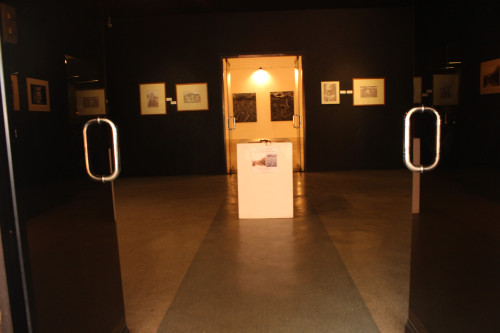
The Corredor is the official gallery of the UP College of Fine Arts. It’s a two-room gallery that implements gallery programs and activities from time to time (could be monthly). These programs and activities are managed by the Exhibition Committee and aim to:
provide art and design experience within the context of the academe, both for the students and the professors.
enhance the capability of the College as archive of art in the University.
develop linkages with cultural and corporations locally and abroad as artistic and cultural exchange program for the students and faculty.
For the month of November, 2015, Corredor is featuring “Isang Sulyap sa Katotohanan” by Neil Doloricon and Joey Tanedo.

Location: UP College of Fine Arts, Bartlett Hall, E. Jacinto Street, UP Diliman, Quezon City
Museum Hours: 8:00 AM - 5:00 PM Monday - Friday
Contact no.: (02) 981 8732, (02) 981 8500 loc. 3977
Email: N/A
Website: http://up-cfa.com/the-college/corredor-gallery/
3. Costume Museum *under maintenance
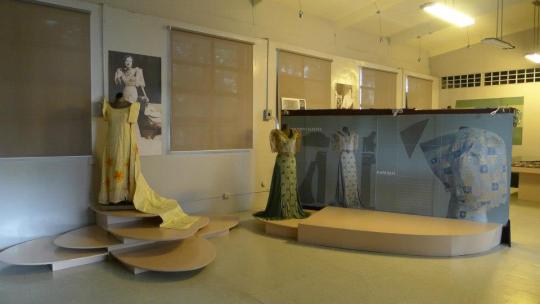
Photo courtesy of Clothing Technology Department
Costume Museum is the house of more than a thousand pieces of historic Filipino costumes and accessories, ranging from shoes, bags, to hats etc. Items are rare and authentic and represent a significant segment of the development of the Filipino cultural heritage.
It is originally located at the second floor of Alonso Hall, College of Home Economics, however, as to speak, the museum will not be opened and for the date of its re-opening, they are unsure yet. :(
Location: N/A
Museum Hours: 8:00 AM - 5:00 PM Monday - Friday
Contact no.: (02) 924 2709, (02) 924 2485, (02) 929 6047
Email: [email protected]
Website: N/A
4. Geology Museum *by appointment

UP NIGS-UPGAA Geology Museum offers a fun and interactive experience for the visitors, especially the students. Sample fossils and specimens are allowed to be touched, earth science videos are also featured in one corner. There are also interactive displays and computer interactive booths among others. The museum was donated by UP Geology Alumni Association in October 2007.
Location: 1st floor, National Institute of Geological Sciences Building G. Velasquez corner C.P. Garcia Street, UP Diliman, Quezon City
Museum Hours: 8:00 AM - 5:00 PM Monday - Friday
Contact no.: (02) 924 2709, (02) 924 2485, (02) 929 6047
Email: [email protected]
Website: N/A

Photo courtesy of UP Diliman
5. Ishmael Bernal Gallery *UPFI is under renovation

Named after the late multiawarding filmmaker, Ishmael Bernal, the gallery features multimedia exhibitions and installations. It is best for intimate film screening and cultural nights.
UP Film Institute, where the gallery is located, is under renovation as to speak. The gallery is closed, but they continually offer film screenings and will only cost you a hundred peso.
Location: UP Film Institute (Back of Main Theatre), Osmeña Avenue, UP Diliman, Quezon City
Museum Hours: 8:00 AM - 5:00 PM Monday - Friday
Contact no.: (02) 926 2722, (02) 926 3640, (02) 981 8500 loc. 2489
Email: N/A
Website: N/A
6. Jose V. Santos Herbarium *on the process of transferring to the new building

Photo courtesy of Jose V. Santos Herbarium
It is a collection of over 20,000 specimens, mainly vascular plants, by Jose Santos, Presciliano Zamora and Leonard Co, three famous scientists in the country. Specimens include grass, fern among others.
Location: N/A
Museum Hours: 8:00 AM - 5:00 PM Monday - Friday
Contact no.: (02) 981 8500 loc. 3728, (639) 179133551
Email: N/A
Website: N/A
7. UP Biology Invertebrate Museum

Photo courtesy of OICA
It started during the 1940s by P. De Mesa and M. Delgado, which included a collection of marine, terrestrial, and freshwater invertebrate specimens. As to date, the Museum has about 5,000 records composed of Arthropods, Cnidarians, Echinoderms and Mollusks.
Location: N/A
Museum Hours: 8:00 AM - 5:00 PM Monday - Friday
Contact no.: (639) 399085457, (02) 981 8500 loc. 3730
Email: N/A
Website: http://www.biology.upd.edu.ph/invmuseum/
8. UP College of Music Museum of Musical Instruments

Photo courtesy of OICA
Home of different musical instruments, the Music Museum is used not only for display purposes, but also for classes, recitals and other events. It is considered a living museum because the display is not consistent due the use of instruments by the students. It features not only local instruments, but also those from abroad.
It first opened in February 1991. As of now, visits are by appointment, depending on the availability of the one in-charge.
Location: 2nd floor, UP College of Music, Abelardo Hall, Osmeña Avenue, UP Diliman, Quezon City
Museum Hours: Monday - Friday
Contact no.: (02) 929 6963, (02) 981-8500 loc. 2635
Email: N/A
Website: N/A
9. Vargas Museum

This is the most famous among the museums and galleries in UP Diliman. It is strategically located along the academic oval and is also known for Zorro’s spot, just in front of the Museum. It houses different exhibits every month, except for the second floor with its permanent exhibit, which is the Vargas Collection.
I feel strongly recommending you to visit the current exhibit of Vargas Museum, especially the one on the third floor. It’s called The Field Trip Project where it aims to feature not-so ordinary bags made my students in East Asia, including Philippines, Singapore and Japan.
Location: UP College of Arts ang Letters, Roxas Avenue, UP Diliman, Quezon City
Museum Hours: 9:00 AM - 5:00 PM Tuesday - Saturday
Contact no.: (02) 929 6963, (02) 981 8500 loc. 2635
Email: N/A
Website: http://vargasmuseum.upd.edu.ph/
Oha! Just like what Sheldon would say “I told you so.” Sometimes we often just pass by on things that matter. But is it our fault? Not really. But as you are now informed, it’s time to do the same job of sharing what you know about other people.
Visiting these places is tiring, but surely is remarkable. Enjoy!
0 notes
Text

by Arra B. Francia
At 65 years old, Nanay Celia is still the breadwinner to two generations down her family line.
I saw Cecilia Bacaran, more fondly known as Nanay Celia in the UP community, seated along the pathway connecting Palma Hall and the ashes of what used to be the College of Arts and Sciences Alumni Association (CASAA) eatery. Her white hair sticks out the most from her physique--- the most telltale sign of her age. As she sells a piece of banana cue to an Iska, she tells me of the time she entered the university.
“Una akong napadpad dito noong 1988. Kailangan ko kasing magtinda para matustusan namin ng asawa ko yung pito naming anak,” she recalls.
Nanay Celia’s dedication to her children’s wellbeing has pushed her to sell different kinds of kakanin. For a price of P1000, her platter is a mix of banana cue, kamote cue, bottles of soya milk, mineral water, and ice candy on some occasions.

Should she be able to sell all these goods, Nanay Celia says she gets a return of an average of P500 daily. While she says this amount is clearly not enough, her family had no choice but to make ends meet.
I then proceeded to ask Nanay the million-dollar question: Why work when you have seven children to support you and do the work for you?
Nanay only laughed at me. So many people must have already asked her that question.
“Nag-asawa kasi agad yung mga anak ko. Tapos ang nangyari, inanakan lang sila. Iniwan ng asawa. Sino pa ba ang tutulong sa kanila kundi ako rin naman?” she explains matter-of-factly.
Aside from supporting her children, Nanay Selia has six other grandchildren, the youngest of whom is only two years old, with the oldest at 12. Three of them are currently in school, so their grandmother gives them P50 everyday for their expenses.
This P150-allowance comes on top of her responsibility to pay their monthly electric and water bills, not to mention the 13 mouths to feed under Nanay Celia’s care.
To make matters worse, Nanay’s sales took a direct hit when a fire razed CASAA in June. With the eatery getting temporary shelter at the back of the Zoology Department of the College of Science, the number of students passing her post has since decreased.
“Iba kasi yung diretso talagang dumadaan papuntang CASAA, ngayon doon na sila dumadaan sa may likod ng AS kaya hindi na nila napapansin minsan yung paninda ko,” sighed Nanay Selia.

Since the fire, her daily sales have gone down to P300. Struggling to ensure that her family not go hungry, Nanay shares that she borrows money at a 20 percent interest every time they go short. I catch my cringe upon hearing this, thinking how this measure would only deplete their resources even faster.
It was already three in the afternoon, but she still had a lot to sell if she were to come home with bills and not more goods. During my 30-minute interview with Nanay, only three students came to buy her kakanin. While I reveled in my thoughts, she advises another buyer to take the banana cue of her choice rather than what the Iska initially took. “Matigas na yang napili mo, hapon na kasi. Ito na lang para masarap pa rin.”
I can’t help but smile at how motherly Nanay Celia is even to UP students. “Mababait ang mga estudyante dito,” she proudly beams. “Minsan nga hindi na nila kinukuha ang sukli. Kunwari dalawa bibilhin nila tapos singkwenta ang pera, di na nila babalikan ang sampu, akin na lang daw.”
As I leave at the end of our interview, she assures me I can come back anytime in case I forgot to ask some questions. I make a mental note that I will come back. And next time, I’ll be the one giving this old, kindly woman a favor instead of the other way around.
ZrTt4K���f7w
0 notes
Text

“Medyo nagulat din yung parents ko. . . akala nga nila kasi UP, mas makakababa ng tuition.”
This was how Anne Villahermosa, a second year Journalism student, described her very first matriculation in the University of the Philippines.
Anne studied first at the Far Eastern University for one year before she decided to transfer to UP. She was a recipient of a scholarship at FEU and she only paid P10,000 for her one year-stay in the university.
In her first year in UP, Anne applied for the Socialized Tuition System or ST System.
The ST System is a mechanism on classifying the students’ capability to afford the UP education based on their socio-economic status. This bracketing procedure has its roots dated way back 1989.
Before the implementation of the very first bracketing scheme in 1989, tuition in UP is pegged at P40 for all UP students. But due to budget cut, then UP President Jose Abueva proposed a tuition increase that gave birth to the Socialized Tuition and Financial Assistance Program or STFAP.
The 1989 version of STFAP was numeric. Those who belonged to the Brackets 1 to 5 received a full subsidy in tuition and other fees with corresponding allowances. Meanwhile, students in Brackets 6, 7, 8, and 9 paid P75, P150, P225, and P300 per unit, respectively.
In 2007, alphabetical brackets replaced the numeric scheme of the first STFAP that resulted to tuition increase. This move was “due to inflation rate between 1989 to 2005” according to the proponents of the said reform. Students that were bracketed under A paid P1,500 per unit and those in brackets B, C, and D received partial subsidy while students in bracket E were fully subsidized.
The ST System replaced STFAP in 2014. According to the official website of the new socialized tuition scheme, “the University may grant tuition discounts and, in certain cases, monthly stipends.”
The tuition discounts are pegged at 33, 60, 80 and 100 percent. In Anne’s case, she was given a partial discount of 60% where she paid P600 per unit for one year.
youtube
As she moved to UP, Anne didn’t expect that her tuition will be higher than her previous school. In fact, her full matriculation for her first semester in UP is already equivalent to the amount she paid in her whole stay in FEU.
“Mas lalong nadisappoint ako [sa sumunod na taon] kasi bracket B ako so 1 K per unit ‘yon. 18 units na ako so 18 thousand, so sobrang laki non para sa akin.”
In her second year, Anne was more disappointed as she was bracketed under the 33% partial discount where she has to pay P1,000 per unit. She is currently taking 18 units for this semester and that amounted to P18,000 plus P2,000 worth of miscellaneous fees. She lamented that the tuition assigned to her doesn’t reflect their financial status. She did not even try to appeal her case for the fear that she may get misassigned to bracket A knowing how flawed the bracket assignment is.
“Binalak kong mag-appeal kaso nga lang, sabi kasi nila kapag nag-appeal ka. . . baka may tendency na maging bracket A pa or ganon, maging worse pa yung bracket ko so parang inisip ko na wag na lang.”
In general, Anne couldn’t hide her disappointment on her matriculation in UP. She argued that the national and premier state university shouldn’t have any socialized tuition scheme as she believes that the UP education is a right.
youtube
She is now planning to apply for a scholarship grant as she continue to get anxious on her tuition for the coming second semester.
“Nai-stress na naman ako kasi bracket B na naman ako o baka maging bracket A pa pero siguro kapag naging bracket A ako, talagang mag-a-appeal na ako.”
(Header image courtesy of Rappler)
0 notes
Text
What’s up in UP?
A timeline of events in the country’s national university
The University of the Philippines may be known primarily for its serious commitment to the academe, but it is also home to colorful and amusing festivities even non-students look forward to. Be introduced to these events (and get to know when they happen) by looking at the timeline below!


0 notes
Text
IN PHOTOS: UP CMC students commemorate 6th anniversary of Ampatuan Massacre
By Renz M. Almenanza
...
var cpo = []; cpo["_object"] ="cp_widget_736d549e-79e4-4360-9904-23222e057cc8"; cpo["_fid"] = "AwKACGNvIGyA"; var _cpmp = _cpmp || []; _cpmp.push(cpo); (function() { var cp = document.createElement("script"); cp.type = "text/javascript"; cp.async = true; cp.src = "//www.cincopa.com/media-platform/runtime/libasync.js"; var c = document.getElementsByTagName("script")[0]; c.parentNode.insertBefore(cp, c); })();
Powered by Cincopa Video Hosting for Business solution.
Students of the UP College of Mass Communication held a silent protest march on Monday as they commemorated the sixth anniversary of the Ampatuan Massacre where 32 of the 58 killed were media practitioners.
0 notes
Text
7 libraries to write that next “uno paper” in

by Arra B. Francia
With exactly 40 libraries across campus, UP students have little room for excuses when it comes to not reaching the minimum required number of sources for that hellish term paper. After all, the university boasts of having the second biggest collection of book volumes in the country--- next only to the National Library of the Philippines. Add that to a growing archive of electronic books and
But, we do understand how hard it is to be faced with a choice on where to stay during study breaks. After all, we go to libraries not just for the books. They’re also about ambiance and the community that surrounds it. Here are seven of our top picks for the best libraries to write that term paper in, or to just get a short snooze while waiting for the next class:
1. Archaeological Studies Program (ASP) library
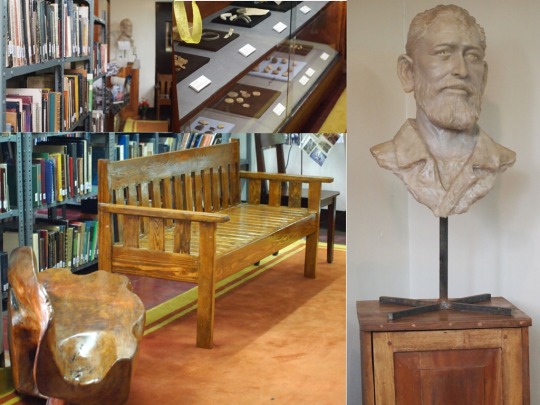
First on the list is the lesser known library in Albert Hall, which houses the university’s future archaeologists. With only general education courses and no major undergraduate courses in the program, the ASP library is seldom filled with students, making it a great place to study in. I stayed here a lot when I was taking up Archaeo 2, and the librarian would even play music from the radio when I was the only one staying inside.
Also, while the bookhouse looks no bigger than two regular classrooms in Palma Hall fit together, it boasts of the one of the most complete collections on archaeological studies in Southeast Asia.
Location: Albert Hall, Lakandula St. cor. E. Jacinto St
Head Librarian: Ma. Theresa T. Lubang
Internet proxy numbers that work: proxy7 and proxy8
Ventilation: Airconditioned
Best when you need to: study in peace
2. College of Arts and Letters Library

Next up is the library of the College of Arts and Letters. With the variety of GE courses offered in the college, the place is almost always filled with students with book in hand--- others even taking short naps. The library is stacked with literary classics and contemporary favorites, ranging from Leo Tolstoy’s War and Peace to JRR Tolkien’s The Lord of the Rings.
Location: Ground Floor, CAL New Bldg.
Head Librarian: Regina N. Murillo
Internet proxy numbers that work: proxy4 and proxy5
Ventilation: Airconditioned
Best when you need to: Find inspiration in writing
3. College of Education library
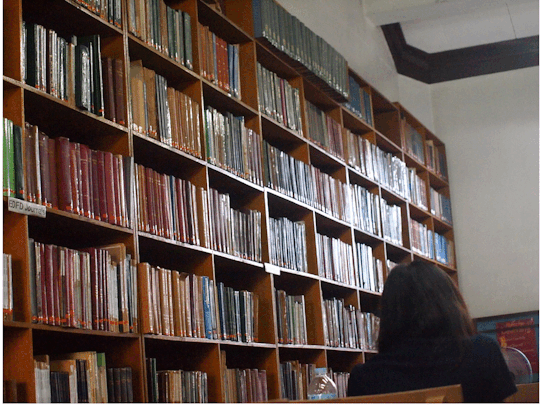
It doesn’t really matter that you still have to take three flights of stairs before reaching the College of Education library. As what you’d expect from the college, they have instruction materials fit for pre-school pupils to college students. The place is divided into four sub-rooms, its walls lined with books from floor to ceiling. The view of the Sunken Garden from the third floor could also help you calm down just in case your study sessions got a bit too intense.
Location: 3rd Floor Benitez Hall
Head Librarian: Verna C. Lee
Internet proxy numbers that work: proxy4 and proxy7
Ventilation: Electric fans in placed between every other table
Best when you need to: Work in close groups
4. School of Economics library

The School of Economics library has a certain gloom about it, probably due to its wide floor area and low ceiling. The individual desks at the side of the room make up for this downside, as they provide lamps in each table. The desks also close you in to your own personal nook, making studying as comfortable as if you were doing it at home.
Location: Guerrero St., U.P. Diliman, Quezon City
Head Librarian: Felicitas G. de la Rosa
Internet proxy numbers that work: proxy7
Ventilation: Airconditioned
Best when you need to: Focus and minimize distractions (esp. when you’re sitting at the individual desk mentioned above)
5. College of Mass Communication library

Making the most out of a small space, the Maskom library is one of the most modern-looking libraries in campus. Five octagon-shaped tables fill the ground floor, while the setting upstairs resemble that of a typical living room on one side and organized tables on the other.
Location: 2nd Floor, Left Wing CMC Annex Bldg., Plaridel Hall
Head Librarian: Teresita D. Santos
Internet proxy numbers that work: proxy7 and proxy8
Ventilation: Airconditioned
Best when you need to: Work in groups
6. College of Engineering Library 2

Among my set of friends, the College of Engineering Library 2, or EnggLib2, is the best-looking library in campus. From desks that allow you to be at your most productive to couches that invite you in for a short snooze, the place really exudes the perfect learning environment.
Location: 1st Floor, UP Alumni Engineers Centennial Hall, Velasquez St.,
Head Librarian: Sharon Ma. S. Esposo-Betan
Internet proxy numbers that work: proxy7 and proxy8
Ventilation: Airconditioned
Best when you need to: Study with a partner and take short naps during study breaks
7. Main Library

The Main Library would not be at the heart of UP Diliman for nothing. Situated at the middle of the Academic Oval to connote that it is the living organ that pumps life into the buildings surrounding it, it has divided into eight service sections: Filipiniana books, Filipiniana Serials, Special Collections, Media Services, General Reference and Electronic Resources, Social Sciences, Foreign Serials, and the University Archives and Records Depository. All databases the university has rights to can be accessed here. And as if the resources of the place aren’t enough, the General Reference Section is open to all students until 12 midnight: truly helping you burn the midnight oil.
Location: Gonzalez Hall, Apacible St.
Internet proxy numbers that work: proxy (no need for numbers)
Ventilation: Electric fans/ Airconditioned in electronic services section
Best when you need to: Study until midnight with unlimited book and journal sources
*This list assumes that students go to libraries in order to study. The “Best when you need to” portion implies only the additional value you can get from choosing one library over the other.
0 notes
Text
Not Another Kristel: UP’s Struggle for the Right to Education
On tuition and the two loudest campaigns regarding it
By Kimberly C. Villegas

"From the Office of Vice Chancellor. Final decision: File LOA.”
It only took a small piece of paper for a college student as young as Kristel Tejada to end her life. It was March 15, 2013, a Friday. She was 16 years old then, and was on her second semester of her freshman year in the University of the Philippines Manila.
Blessilda came up to Chancellor Manuel Agulto and pleaded, "almost at the verge of kneeling in front of him”. Christopher recalled how quick they were to write a letter of repentance addressed to Vice Chancellor for Academic Affairs Josephine de Luna, as instructed by Agulto. They had to do everything it takes just to keep their eldest child in school, as schooling for Kristel "was her life and hope."
All of these was due to a nearing deadline for the payment of tuition for the second semester, which for the Tejada family was a deadline "impossible" to meet.
Christopher, Kristel's 40 year-old father, managed to land a job as a driver just a few days before she filed the income tax return as part of the Socialized Tuition and Financial Assistance Program (STFAP) application process. Their payment for the tuition for the first semester was late, but still they were able to do so.
Kristel grew up as a responsible ate and a student. The lack of her family's financial capability did not stop her from attending school. "Even if she was hungry, she would go to school,”said Krizia.
However, Christopher's salary of Php500 a day did not suffice to pay his daughter's tuition on time. Kristel survived her first semester as a Behavioral Science student through promissory notes. And to add insult to injury, Christopher lost his job two months after he got it.
"We really struggled to get by. There was a time I was selling newspapers for a living. I would earn $0.05 per copy. Imagine what would happen to us if I only managed to sell six copies?" said Christopher.
Krizia firmly believed that it was the instruction for her sister to file a forced leave of absence that provoked her to commit suicide
"I know that we cannot put all the blame to UP Manila. But it was the biggest factor...There were bigger problems that we faced in the past. Even if we hardly get a good meal, we stayed together. We remained strong,”Krizia said.
"If the main reason is our family problems, she could have (committed suicide) ages ago.”
Krizia added, "She wanted to be a doctor because she wanted to save people’s lives. It is no longer possible now. But in a way, I would like to think that she still saved others — the youth who wants to study but could not afford it,” Krizia said.
History Repeats Itself: STFAP to STS
It turns out, ironically, that the UP's socialized tuition was "part" of the plan to "democratize access and admission to its academic programs while promoting fairness and social justice in the University, befitting its status as a state-supported institution of higher learning" (BOR Resolution, 30 Jan. 1989, as qtd in Mendoza, et al., 2014). It was claimed to be necessary in order to make UP education affordable, especially for those who come from poor families.

infographic courtesy of UP Journalism Club
Socializing tuition was originally suggested by Dr. Manlapaz in his team's report in 1976. 13 years after it was recommended, Former UP President Jose Abueva implemented the Socialized Tuition and Financial Assistance Program (STFAP) in 1989. The recommendation had no details; it was merely "premised on the argument that those who can afford should pay more".
For 22 years, the STFAP had served as the UP System's tuition scheme, dividing students into brackets based primarily on their annual family income. Their assigned bracket will determine the amount they have to pay as tuition fee or the corresponding benefits they will receive.

STFAP received several criticisms from various stakeholders not only due to frequent cases of bracket mismatches, but also due to high processing cost . In a report by the Study Group on Admissions entitled "Democratizing UP" submitted to University of the Philippines (UP) President Alfredo E. Pascual on January 2014, the processing of STFAP was estimated as P1,000-P3,000, a cost which includes transport, photocopying documents, documentary stamp tax, notarial fees, etc., according to the report), and appeals for mismatches take long to be processed again.
According to the report, Former UP President Roman admitted that because the government approves budget for UP that is always averagely 40% lower than requested, the State University had to design the STFAP "to earn income from tuition".

infographic courtesy of Philippine Collegian
After a series of revamps that apparently led to higher tuition fee, The UP Board of Regents for the third time has again updated the socialized tuition scheme, this time replacing the 24-year-old STFAP with Socialized Tuition System or STS. Aside from its new name, STS promises to “speed-up the processing of tuition bracket applications, adjust income brackets of student applicants, and increase the stipend of poor students.” Now done online, the STS reduced STFAP’s 14-page application (which used to last up to 10 months) form to two pages, and the number of indicators for applicants from four to two.
Under the STS, the income cut-offs for brackets A, B, C, and D will be adjusted “upward” “by 30 percent” to address the drift towards upper brackets as income rises due to inflation. Therefore, a lot of students should find themselves in lower tuition brackets.
Based on the data obtained by the Philippine Collegian from the Office of Scholarships and Student Services (OSSS) as of September 16, 2014, the number of students paying the full tuition rate of P1,500 per unit have spiked by 43 percent--from 5,112 in 2013 to 7,307 in 2014.
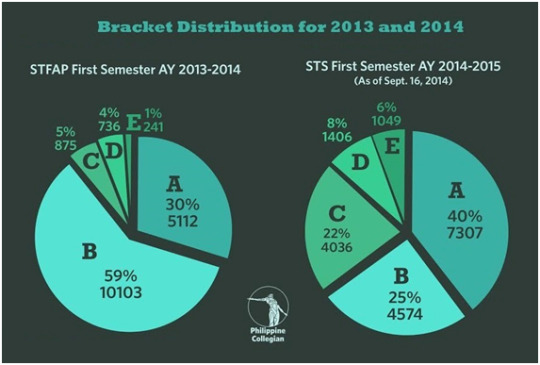
infographic courtesy of Philippine Collegian
Social Equity
Krizia, for her part, criticized the ‘no late policy’ of UP, which was withdrawn by the UP administration following Kristal’s death.
“All students, especially the poor, should be given an opportunity to finish their education. If they are really after the tuition, then there are other ways such as putting students’ card on hold. But it would be a lot better if they would just lower the tuition,” said Krizia.
The continuous increase in tuition fee along with the emergence of other school fees pushed the students to consistently call for the scrapping of the socialized tuition scheme, which later on was strengthened as the alliance called “Rise for Education” (R4E) was founded three years ago. However, a new campaign has emerged, calling for an action similar to Krizia’s but different from Rise for Education's (R4E)--reform the STS.
Progressive Alliance for the Rollback of Tuition and Accessibility of Education (PARTAKE) is an alliance of youth and student organizations “calling for a progressive tuition rollback and a more accessible education in the University of the Philippines.”
Similar to R4E, PARTAKE believes that education is a right of which no single Filipino should be deprived. However, their means to assert that right is different.
Formed around July 2015, PARTAKE has launched its campaign in UP Diliman, Manila, and Los Baños.
PARTAKE sees nothing wrong with charging students with tuition fee, as long as the student pays only the amount that he or she could pay for. The administration, PARTAKE lobbies, should decrease the rates per bracket and increase the stipend for the lower brackets.
Aside from rollback, PARTAKE also calls for a number of ST reforms. Some of these are: review of MORES-1sec as a tool in measuring the capacity to pay in order to address the problem of mis-bracketing raised by the student body; providing of guidelines in answering the ST System survey; making the answering of the ST System a requirement for the students in order to prevent mis-classification of students under “No-Discount” bracket due to failure to answer the survey questions; providing of equal applications to all UP students inclusive of the graduate students and double degree majors; and ensuring that local committees that approve appeals will adopt a uniform system of approving them via a trust-based system.

infographic courtesy of PARTAKE
All those reforms proposed were clearly feasible, but an important question is: IS A ROLLBACK POSSIBLE?
According to PARTAKE, yes it is.
Last year, the UPD University Student Council conducted a survey showing that students find the current tuition rates expensive, the answer to which—as PARTAKE believes—is rollback. As one goes down the income brackets, the burden (tuition as percentage of income) increases. This is an alarming fact because in an ideal socialized tuition scheme, those in the lower brackets should be burdened less—PARTAKE’s “progressive” way.

infographic courtesy of PARTAKE
In the said research, the alliance found out that UP has a total of Php 20B worth of time deposits which are being left unused, and earns an interest income of Php 232M from all its assets and investments
PARTAKE therefore proposes to add P1,000 stipend to both Brackets E1 and E2, and reduce the rates of Bracket A because “the system is stil imperfect in giving the correct brackets. We need to reduce the 1,500 as a safety cushion for those who will be mis-bracketed.” The alliance also proposes an additional
Right now, PARTAKE has submitted their proposal to on the University Committee on Scholarships and Financial Assistance (UCSFA) and the UP Board of Regents.
Free Education For All
While Kristel’s sister sees tuition as an OK thing as long as there will be a rollback, his father Christopher dismisses reforms as “mere band-aid solutions.”
“Are these solutions? This is UP, so education should be free. The time to fight the system is now. I’ve lost a daughter because of that”.” (Italics mine)
A big chunk of the student population of UP has been sharing the same sentiment ever since tuition in UP was socialized, which R4E has been putting forward along with their campaign against Tuition Fee and Other School Fees (TOFI) increase and commercialization schemes.
R4E is an alliance of different student councils and publications from high schools and universities, youth organizations, members of the academe, parents, out-of-school youths and citizens form all walks of life calling for a quality education that is free and accessible to all, regardless of your socio-economic status.
R4E members firmly believe that education is a right, and therefore must be given to students by the government for free for each and every Filipino student. It is absolutely discriminatory, they say, for rich students to be the ones paying for the tuiton of the poor, especially because education is a government mandate.
By “free education”, R4E members mean zero tuition fee, other school fees, dorm rentals, and venue rental fees, and a socialized stipend system, “kasi part yun ng karapatan sa education--pagkakaloob ng free at accessible na basic student service.”
Aside from the fact that education is a constitutional right, R4E stands their ground against all forms of socialized tuition scheme as it has clearly become an “income-generating” mechanism.
According to Tilendo, the socialization of tuition fees in State Universities and Colleges (SUCs) perfectly fits into President Aquino’s Roadmap to Public Higher Education and Reforms (RPHER). “Actually, mismong nakalagay do’n na lahat ng SUCs ay dapat maging self-sufficient na; magkaroon ng socialized tuition schemes para doon makuha yung pang-maintain ng universities.” This, as R4E sees it, is a clear form of “panggigipit sa mga estudyante”.
The instruction to SUCs to be self-sufficient serves nothing but as a reason to implement STFAP reforms after reforms that only lead to increased tuition, says Tilendo—increased tuition which yields big fund more than enough to sustain the university.
“Kung iisipin mo, yung STFAP, yung lahat ng socialized tuition--STFAP, STS--kung ano man yang form or anong reform yan, 3 decades syang nag-exist. Eh sa tinagal-tagal ng Unibersidad ng Pilipinas nakaya natin na mag-aral nang walang binabayarang tuition in the very first place. So bakit bigla silang magi-implement at lalong pinapalala?
“Kasi, for example, 1.9B y’ung nasingil mo sa tuition tapos 150M lang y’ung kaya nilang gastusin for financial assistance. Ang laki laki ng pera ng UP. ”
And where do the excesses go? To the “revolving fund”.
“Alam natin kung saan napupunta, or alam natin na walang napupuntahan yung tuition kundi sa revolving fund at ginagamit for corruption, and ginagamit ng government na panggastos,” said Tilendo.
As for people who are raising their eyebrows on R4E’s call for socialized stipend while calling for a free tuition, Tilendo explains, “Magkaibang usapin kasi y’ung tuition and financial assistance. Syempre, y’ung financial assistance, socialized sya, in a way na mas matutulungan mo y’ung mas nangangailangan. Pero tulong kasi y’un. Hindi sya tuition na babayaran nila y’ung kaya lang nilang bayaran....Magkaibang bagay y’un.”
R4E’s campaign, which has been consistent even before the alliance was built, is in stark contrast with that of the newly formed alliance PARTAKE. For R4E members, progressive rollback “does not address any problem at all”, rather “makes the situation worse”.
“Kumbaga compromise eh. Sige, mataas yung tuition kaya babaan natin para OK sa student. Actually in the first place hindi OK at all...In the very first place hindi dapat tayo sinisingil...Kaya nating mag-aral nang walang tuition.”
“Ang hindi nila nare-recognize is UP, state university sya--public university. Walang pagtingin, walang recognition, na commercialized y’ung education...Kumbaga semi-private or profit-oriented y’ung UP kasi nga may "scarcity"...na parang "each according to kakayanang magbayad".
From 2010 until this year, 94% of all UP students from all UP units pays tuition, while only 6% studies for free. Out of the majority, 40% is classified under Bracket A.
“Kapag naniningil ka ng tuition...hindi ka naniniwala na in the first place ay karapatan yung edukasyon,” said Tilendo. “Ginagatasan mo yung students hanggang kaya niyang magbayad. So kahit i-bracket mo pa yan na for example proposal mo na 1500 y’ung base tuition ngayon, babaan mo sya sa 1000 pesos kasi feeling mo progressive y’un, or from 1000 gagawin mong 300, so progressive yun? Actually, regressive pa y’on kasi in the first place, y’ung maximum na kakayanan ng student na magbayad, hangga’t kaya mong maningil, maniningil ka...Utak admin yun eh! Anti-student.”
#feature#junk sts#reform sts#scrap sts#progressive rollback#rise for education#r4e#PARTAKE#tuition fee increase#tuition#up diliman#UP#free education for all#social equity#right to education#students#college#tertiary education#tuition fee
0 notes
Text
5 PLACES TO GO DURING HELL WEEKS
by Precious Prestosa

Photo courtesy of Dianne Grace Cirunay
It’s the time of the year again when sleep is considered a luxury and coffee is every Isko and Iska’s best friend. With all the exams, papers, plates, and other requirements our academics and other activities require of us, it is best to know where to go when you wish to be productive in your academics and extra-curricular activities. Below are five of the best study places around UP Diliman that are highly recommended for every student to try.

1. Bo’s Coffee
Location: 329 Katipunan Road cor. B. Gonzales Street, Loyola Heights, Quezon City
Contact no.: (02) 442 5614
Email: [email protected]
Website: boscoffee.com, fb.com/boscoffee
Opening Hours: 24 hours Sunday - Saturday
Price Range: Php100 - Php300
Commodities: Wifi (a receipt entitles access to wifi, but is limited to two hours), airconditioner, electric outlets, smoking area
Landmarks: Dormitoryana, Miriam College

Probably the most in-demand among others, Bo’s coffee offers college students conducive place to study, with its three-story building and several electric outlets. Bo’s coffee serves variety of foods such as bread, cheesecakes, cakes, ice cream, rice and pasta meals. Best to try their New York Cheesecake and its like having the best time of your life!
2. Hillcrest Wellness Café

Location: 48 Malingap Street, Sikatuna Village, Quezon City
Contact no.: (02) 433 2129
Email: [email protected]
Website: hillcrestwellnesscafe.com, fb.com/HillcrestWellnessCafe
Opening Hours: 7:00 AM - 1:00 AM Sunday - Saturday
Price Range: Php100 - Php200
Commodities: Wifi, airconditioner, electric outlets, books
Great ambiance is what gives Hillcrest Wellnes Cafe an upperhand among others. Surrounded by artworks and books, Hillcrest invites customers to be productive in their study and/or work. They have quite a reliable wifi connection relatively to other study places. If you want to study in groups, it is wise to try their teas or pressed coffee because of its price and volume.

3. Starbucks Matalino
Location: Matalino Street, Diliman, Quezon City
Contact no.: (02) 376 6581
Email: N/A
Website: starbucks.ph
Opening Hours: 6:30 AM - 2:00 AM Sunday - Saturday
Price Range: Php100 - Php200
Commodities: Wifi (you have pay an additional Php70 which is also limited to an hour), airconditioner, electric outlets, books, parking space
Landmarks: Shakeys, McDo
Starbucks, in general, is probably one of the most common coffee shops here in the country. Starbucks Matalino, however, offers a more aesthetically appealing interior that adds to the coziness of the place. This shop is known for its frappucinos, but aside from that, their cheesecakes and mango madness cake are must-tries. It tastes like heaven, I swear!!!

4. The Hideout Cafe
Location: 21 Malingap Street, Teachers Village, Quezon City
Contact no.: (639) 267301490
Email: [email protected]
Website: fb.com/TheHideoutCafeOfficial
Opening Hours: 2:00 PM - 12:00 AM Monday - Saturday
Price Range: Php60 - Php175
Commodities: Wifi, airconditioner, electric outlets, books
Landmarks: Ally’s All Day Breakfast, Tomato Kick

I’ve tried so many coffee shops, but The Hideout Cafe has the most reliable wifi connection among study places around UP Diliman. Not only that the connection is fast, but it’s also quite stable. It also offers the best food, especially the Mushroom Carbonara, which will make you feel overwhelmed right after you’ve had your first taste. The place is relatively small, but it is really nice and cozy. If you really want to have a quite time to stay and study, this might be the best option for you.
5. UP Main Library
Location: Gonzales Hall, Apacible Street, UP Diliman, Quezon City
Contact no.: (02) 981 5000 loc. 2852, 2861
Email: [email protected]
Website: mainlib.upd.edu.ph
Opening Hours: 8:00 AM - 12:00 AM Monday - Saturday
Price Range: N/A
Commodities: Wifi, electric outlets (you have to use your pink card or else you’ll pay hourly charges), books, computers, printers
Landmarks: Sunken Garden, Palma Hall, Palma Hall - Annex

Let us not forget the main library of every Isko and Iska. UP Main Library is the most accessible study place for UP students because of its proximity. Wifi connection reliability varies on different times. As a library, it is a given that it offers ample space for students to stay. We can also maximize our benefits as UP students as we can use the online databases of UP Diliman, have your papers be printed right away, etc.
Having laid out all these, it is important to remember that success is still dependent on the individual. Finding your solitary place which you can call your own and where ideas keep coming and inspiration is overflowing is still the best option towards productivity. Have fun! •
0 notes
Text
Beyond UP’s dirty secrets

by Arra B. Francia
There is no doubt that UP stays true to its reputation of providing discourse in the widest range of topics. But give that reputation a mix of anonymity, and you’d get tales that may be too much to handle even in a university as free as ours.
I am referring to The Diliman Files, a Facebook page that allows users to send in their stories anonymously by filling out an online form. Launched in 2013, the page currently has over 189 thousand likes with posts ranging from crush confessions to political ideologies to the occasional existentialist crisis. The administrators of the page, who have also kept themselves anonymous, post at least 25 times a day and have promised to do so in order to deal with the pile of “confessions” they receive every day.
While some of the posts tackle typical UP life (i.e. complaining about getting zero units in the Computerized Registration System), there are times when they get out of hand. For instance, this post from December 29, 2014 talks about how a guy can’t stop touching himself while reviewing his lessons:

Another post didn’t even worry about his language, and the vision his words would leave his readers with:

Since TDF is a public page open to the entire online community, it is inevitable for non-UP students to read its content. Some might say that this is potentially damaging to the university’s image, as it would give the perception that UP students have nothing on their minds but sex. There is a huge gap in the openness in which we discuss these issues. Put this in contrast with the recent campaign by students from the University of Santo Tomas calling on the administration to lift the ban on hair dyes and UP would look like the champion of freedom.
While I agree that the posts may be too much sometimes, such vulgarity is necessary and actually a welcome factor in a democracy. The topic of sex has been a taboo for too long in the Philippines, when sex education could actually be used to control population in the country. There are currently 100.09 million Filipinos, according to the Philippine Statistics Authority. Being aware of the process of reproduction through an environment that talks about it without reservations could help us slow down our population growth.
Alongside the articles mentioned above, there are actually ones that have evolved into a cause. The pinned post on their home page is about a UP student with a meager weekly allowance of P300, whose dad has a cyst on his back, whose grandmother needs financial assistance for her medicine, and so on.

Read complete post at: https://www.facebook.com/updconfessions/?fref=ts
The thing is we have to accept that sometimes the good has to come with the bad. TDF is just another manifestation of the greatness of freedom of expression in UP. I remember reading a line from our media law class: “The remedy for speech is more speech.” We must never censor or limit a person from speaking out just because it may be taboo or too sensitive for others. •
0 notes
Text
Kwentong UP
By Kimberly C. Villegas
UP people, no matter how diverse its population is, are bound by the inherent characteristics of Filipinos with which we pride ourselves with. Some of those are creativity, humor, and belief in superstitions and spirits, the result of which are UP Diliman tales that a typical Filipino would more often than not believe or confuse as facts.
Freshies are the most innocent and gullible when it comes to such stories, and knowing them before a naughty senior student tells them to you exaggeratedly would somehow help you manage to brush them off and just laugh at them.
But how true are they?
1. FPJ, Sr. is Oble.
Everybody kept spreading it, but no one barely even knows why or when exactly was Fernando Poe Sr. "chosen" as model for The Oblation. Or, the proper phrasing is, why or when exactly was the name of Poe Sr. dragged into the creation story of The Oblation. Even up to this day, no one could really explain how the rumor started. The only sure thing is that Poe Sr. was a student in UP during the time that National Artist Guillermo Tolentino, who was then a professor at the UP School of Fine Arts, was creating Oble.
Yes, you read it right. Poe's clan might be a family of good body genes, but the credit for Oble's physical features should not be given to Poe.
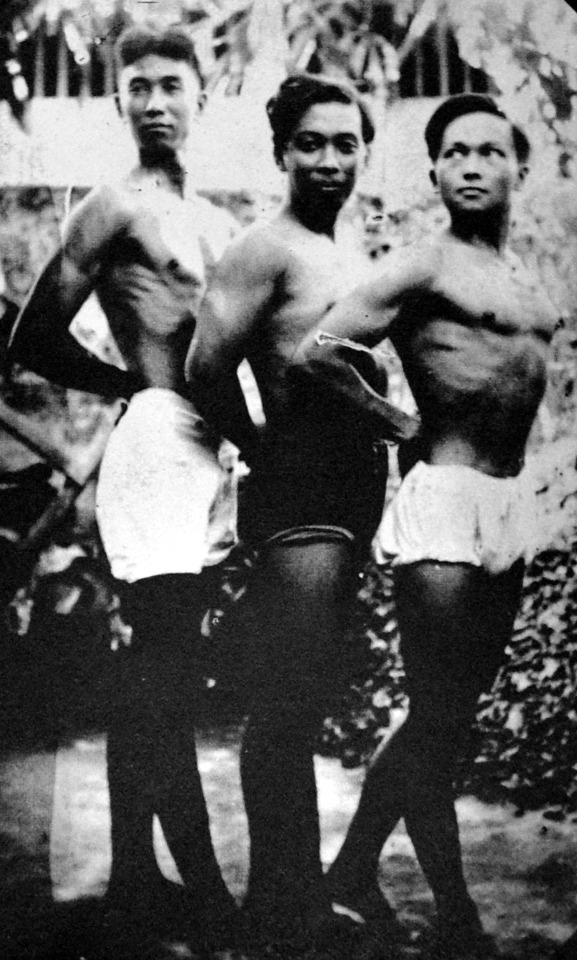
(left to right) Virgilio Raymundo, Guillermo Tolentino, Anastacio Caedo
photo courtesy of up.edu.ph
According to a book written and designed by the late UP Diliman College of Fine Arts Prof. Rodolfo Paras-Perez entitled Tolentino, Oble is a product of the combination of two not-so-popular men: Prof. Anastacio Caedo, who was then Tolentino’s student assistant, and Virgilio Raymundo, brother of Tolentino's wife Paz Raymundo-Tolentino. Oble's physique was modeled after Prof. Caedo; the proportion, from Raymundo.
Even the other Oblation statues, especially their facial features, were patterned after Prof. Caedo's. UP Open University (UPOU) Chancellor Grace Javier Alfonso, who was a graduate of UPD College of Fine Arts, created the Oblation statues located at the UPOU Headquarters in Los Baños, Laguna; the UP Manila (UPM)-Philippine General Hospital compound; the UPM School of Health Sciences in Palo, Leyte; and the UPM School of Health Sciences in Koronadal, South Cotabato. In her message to UP Newsletter, Alfonso recalled her then professor Caedo telling her to remember that he was the model for the Oblation. As she created the other Obles, she kept on checking and re-checking the facial features, and told the UP Newsletter, “it really looks like him.”
2. The Sunken Garden is really sinking.

Photo courtesy of KoolBeep
Before you panic and pack your bags away from UPD, let me tell you this: IT IS NOT SINKING. So for the incoming freshies out there who are planning to join a tour for freshies, you now have an immunity from the wrongly-informed senior students who would say that the Sunken Garden is sinking at a rate of 1-10cm a year.
The rumor is due to another rumor: a fault line, which many believes as the West Marikina Valley Fault, runs through the campus' Academic Oval, hitting the Sunken Garden. In an interview with the UP Newsletter, Prof. Alfredo Mahar Francisco A. Lagmay of UPD National Insititute of Geological Sciences shares the story that sparked the myth.
Geology students under Prof. Ernesto P. Sonido’s class were tasked to survey the Diliman campus. One or more of the students, while studying the shape of the Sunken Garden, came up with the idea that its shape could be explained by a fault line running under it. As to why the idea was passed on from generation to generation, no one could explain.
Prof. Lagmay begs to disagree, as the Marikina Valley Fault is actually 2 1/2 to 3 km away from UP. And although there are faults running across the campus, none of them directly hit the Academic Oval.

photo courtesy of up.edu.ph
There are also no studies that show that the Sunken Garden and the library are really sinking. The reason why the Sunken Garden is sunken, Prof. Lagmay theorizes, is the campus waterway system. In an interview with the UP Newsletter, Lagmay pointed out a creek from Philcoa, which goes into the UP campus, passes through the lagoon, is split into two around the area of the Main Library, and cuts through the sides of the Sunken Garden. That creek, as Prof. Lagmay suspects, was filled with soil, forcing the water to divert from its original flow.
3. Pose with Oblation, postpone your graduation.

Photo courtesy of halboor.com
"Wala namang mawawala kung maniniwala ako, hindi ba?"
If you, however, did not believe that a photo with Oble will cast a curse upon your supposedly 4 or 6 years in UP, you will lose one important thing: on-time graduation.
People in UP are intellectual beings, yet their Filipino blood with a tint of mapamahiin trait make them ignore the fact that this belief has no scientific basis. No one knows how or when this myth started spreading around but its popularity is so high that the tale has reached the other UP campuses.
"Mahirap makapasok, pero mas mahirap makalabas," is a saying that most of the UP students could conclude and relate to. But don't blame it on Oble, because if there is someone who could affect the length of your stay in UP, it is you and how you strive to meet the high academic standards of your beloved State University.
4. An Ikot ride at midnight.

If the previous tales have a touch of humor and creativity, this one has horror and goosebumps-inducing possibility.
An iska was on her way to her dorm one late night and found herself alone in an Ikot jeep. Nearing the dormitory, the iska shouted "para po!", but the driver only glanced at her in the rearview mirror and continued driving. They wheeled through the dark and silent streets of the campus--a route that the iska could not recognize. Finally, they made a turn and the driver dropped her off directly in front of her dorm. Mildly shaken, the iska hurriedly left the jeep, but the driver called after her and instructed her to burn her clothes as soon as she gets home. It turned out that the driver took a different route to ward off the evil spirits that could be following her. Why?
"Pagtingin ko kasi kanina sa salamin, wala kang ulo."
#tips#urban legends#myths#up diliman tales#ghost stories#FPJ Sr#oble#oblation#sunken garden#marikina valley fault#west marikina valley fault#graduation#ikot#feature
0 notes
Text
What to know as a first-time dormer
by Precious Prestosa
Your dormitory will be your second home. There you will meet new people, from far places like yours, cultured in their own. Together, you will discover things, create relationships, build each other up, love, hate, survive, succeed, etc.
Adjusting in college life is one thing, adjusting in UP life is another thing, and mind you, adjusting in a dorm life is also one separate thing. A lot of our Isko and Iska came from the provinces. The experience could either be liberating and beautiful, but also scary and nerve wracking.
So we ask, what to know as a dormer in UP Diliman?
If you’re reading this and plans to stay in a UP dorm, whether a freshie, sophomore, junior, or even a senior,I tell you fella, you’re on a right track!
1. Know the where-tos around your dormitory.
Even before actually checking in your dormitory, it is best to have checked significant places for you as a dormer. You should know where to eat, where to buy your medicine, where to bring your laundry, where to pass your papers, etc. Knowing all these won’t make you feel lost and will actually save you time (trust me, fretting where to eat is a troublesome matter).
For Kalayaan, Acacia, Sanggumay, Molave, Yakal, and Ipil dormers, praise the Lord, for almost everything is provided to you. These dormitories are very strategic because they are near Area 2, an entire compound of food places for you, and Shopping Center that could actually offer you more than you can imagine.
For Kamia and Sampaguita dormers, theirs are near CASAA (even with the new CASAA), and both dormitories have Ate’s who sell breakfast, lunch and dinner just outside the dormitories. They are also near AS, CAL and CS where most of the GE classes are held.
Lastly, for Kamagong and Cente dormers, worry no more, for the new Food Nook and UP Cafe offers you affordable and delicious food, best to have even while you’re studying. Not satisfied? You still have KNL and Maginhawa near you.
2. Be friends with your roommate/s.
This is actually significant, especially to those who are just in their freshmen year. If your dormitory will be your second home, your roommates are supposed to be your secondary family as well.
When you think you forgot something very important in your room, and it so happens that your rooomate hasn’t had his/her class yet, he/she is just a text away. When you left your key, your roommate could open the door for you. When you need something in an ungodly hour, they are your immediate help. Realize that!
3. Be friends with Kuya/Ate Guard (and others)
This is actually funny, but you should know this. I won’t elaborate this much further, but I will tell you that this maybe the most beneficial in your stay for years as a dormer. The secret to best dorm life is having a favorable one that could come from the people around you, from the admin staff to the maintenance staff.
Ate and Kuya Guards have the keys and records of your violations! They can excuse you if they want to. Want that?
4. Speaking of violations, be wary of yours.
They actually consider this when you’re applying for re-admission next year. Don’t be forgetful. If you think you’re in danger, go back to number 3.
5. Always have a food stock.
It doesn’t have to be so many. You just need it in case you’re pulling an all-nighter and you suddenly become hungry. You can have your food delivered, sure, but it’s too costly. Plus, you can share it with your roommates, just like what I’ve been doing. Hehehe
6. Don’t think you have all the money in the world.
Living separately is too costly. You have to mind on the things you haven’t minded of before. Don’t spend too much on something and you will just be startled by the question, “Where did all my money go?”
Also remember that you allowance isn’t daily anymore and it’s not all food.
7. Join activities. Create your network.
Your roommates, dormmates, classmates are future engineers, businessmen, scientists, artists, politicians (ohmy!) of this country. You are studying in the premier university, for God’s sake!
Besides, studying in UP is so stressful. Dorm activities are one way to let your mind off things, have a good night and be at peace.
8. Be responsible enough!
You are now living an independent life, away from what you’re used to, away from your family and places you are comfortable with. Even if you can depend on your friends, you should know how to stand at your feet and be able to do things alone.
Your friends will not be with you 24 hours of the time. They have their own life, you know! Besides, why stay in the dorm if you will not grow?
9. Trust in yourself.
Of course, you have to believe that living an independent life isn’t all scary. Embrace a new beginning and make the most out of your new life. Share moments, dream and fulfill it!

(Kalayaan Residence Hall)

(Molave Residence Hall)

(Yakal Residence Hall)

(Acacia Residence Hall)
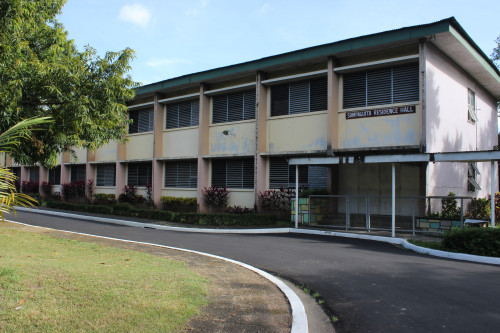
(Sampaguita Residence Hall)

(Kamia Residence Hall)
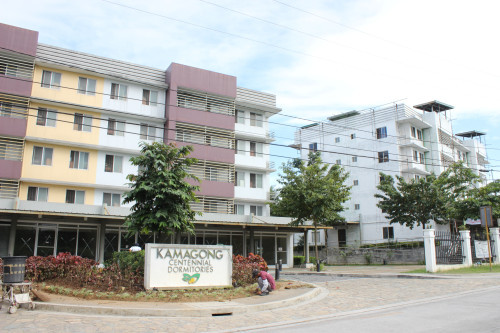
(Centennial Residence Halls)

(Kamagong Residence Hall)

(Sanggumay Residence Hall)

(Ipil Residence Hall)
0 notes